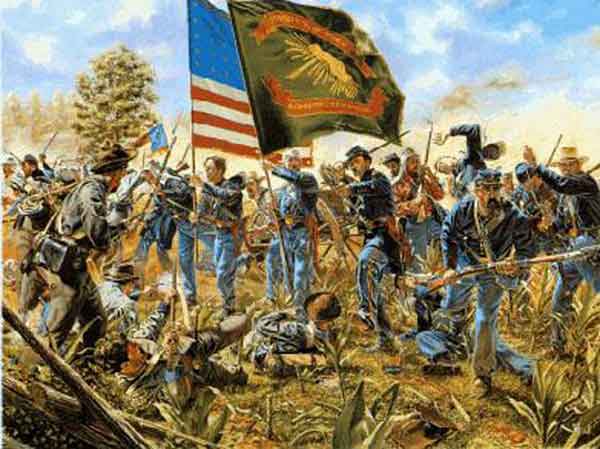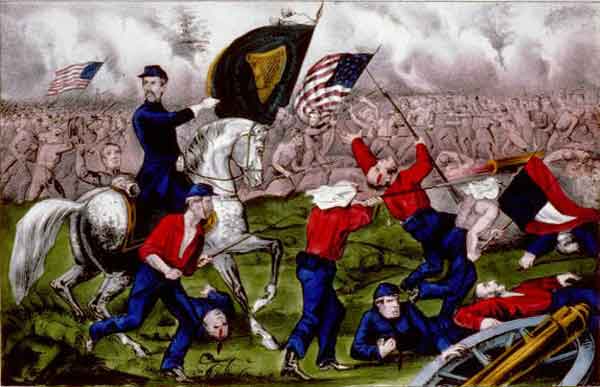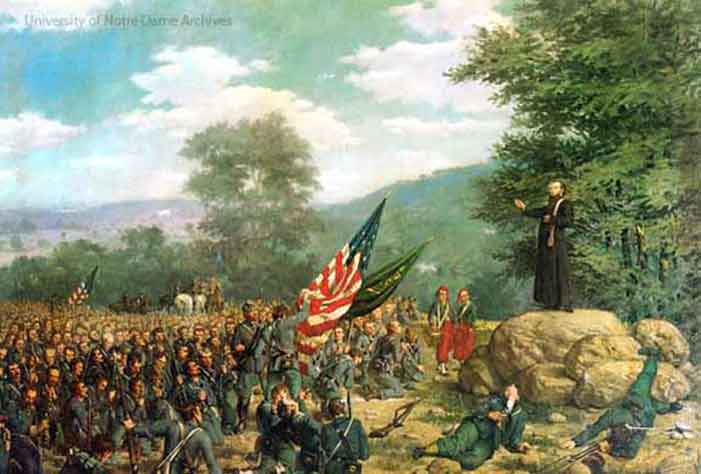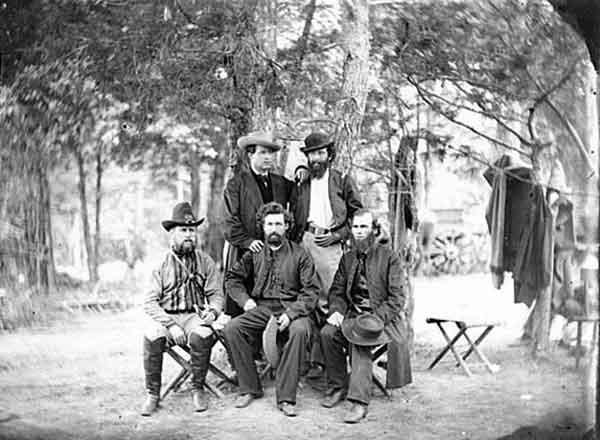The Fighting 69th
The Irish Brigade – The Fighting 69th
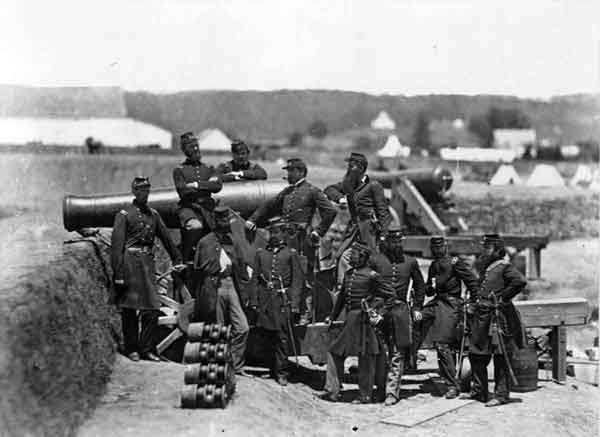 On April 15, 1861, shortly after Fort Sumter in Charleston, SC surrendered to the Confederates whose bombardment of that US Fort was the first shot of the American Civil War, President Lincoln called for 75,000 volunteers to defend the Capitol. The second regiment to march from New York City in response to that call was the 69th New York State Militia commanded by Colonel Michael Corcoran, born in County Sligo, Ireland in 1827. He is standing on the left, his left hand on the left wheel of the siege gun carriage. He, the officers and men of the regiment built and manned Fort Corcoran in the Spring of 1861 near the Capitol. The only Officer on the far side of the gun, leaning on the tube and looking directly into the camera is Captain-Acting Major, Thomas Francis Meagher born in Waterford, Ireland. This photo is courtesy of the Library of Congress.
On April 15, 1861, shortly after Fort Sumter in Charleston, SC surrendered to the Confederates whose bombardment of that US Fort was the first shot of the American Civil War, President Lincoln called for 75,000 volunteers to defend the Capitol. The second regiment to march from New York City in response to that call was the 69th New York State Militia commanded by Colonel Michael Corcoran, born in County Sligo, Ireland in 1827. He is standing on the left, his left hand on the left wheel of the siege gun carriage. He, the officers and men of the regiment built and manned Fort Corcoran in the Spring of 1861 near the Capitol. The only Officer on the far side of the gun, leaning on the tube and looking directly into the camera is Captain-Acting Major, Thomas Francis Meagher born in Waterford, Ireland. This photo is courtesy of the Library of Congress.
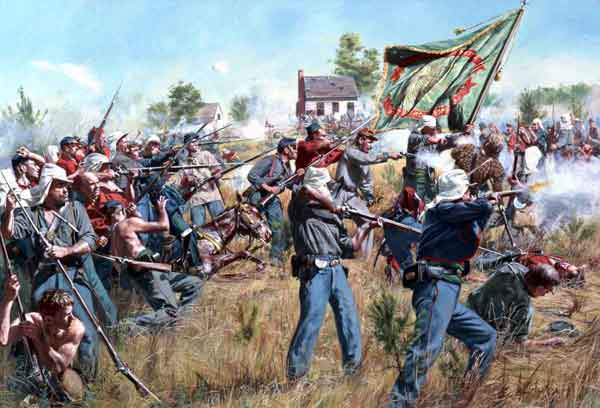 The 69th New York State Militia is depicted in action at the first Battle of Bull Run, July 21, 1861. They were part of Sherman’s Brigade which was fed into the fight piecemeal. Depicted is their afternoon fight on the plateau of Henry House Hill with the remnants of the 11th New York Fire Zouaves [who had previously attacked] against the Confederates’ remnants of Bee, Bartow and Evan’s Brigades and Jackson’s newly arrived Brigade and artillery. After several attacks and counter attacks, the 69th NYSM will try to fight as a rear guard, but they will join the retreat. Captain Thomas Francis Meagher is shown just to the left of the horse that is down, extending his arm and his sword toward the colors of the 69th New York. Colonel Corcoran will be captured. Colonel Corcoran will be offered parole in exchange for refusing to take up arms against the Confederacy. He refuses and will not be exchanged until 13 months later. He is appointed Brigadier General of Volunteers, recruits Corcoran’s “Irish Legion” and while commanding a Division of the XXII Corps in defense of Washington City his horse fell on him while he was riding alone, fracturing his skull and killing him on December 22, 1863. This painting by Don Troiani is titled New York’s Bravest. It is courtesy of www.historicalimagebank.com.
The 69th New York State Militia is depicted in action at the first Battle of Bull Run, July 21, 1861. They were part of Sherman’s Brigade which was fed into the fight piecemeal. Depicted is their afternoon fight on the plateau of Henry House Hill with the remnants of the 11th New York Fire Zouaves [who had previously attacked] against the Confederates’ remnants of Bee, Bartow and Evan’s Brigades and Jackson’s newly arrived Brigade and artillery. After several attacks and counter attacks, the 69th NYSM will try to fight as a rear guard, but they will join the retreat. Captain Thomas Francis Meagher is shown just to the left of the horse that is down, extending his arm and his sword toward the colors of the 69th New York. Colonel Corcoran will be captured. Colonel Corcoran will be offered parole in exchange for refusing to take up arms against the Confederacy. He refuses and will not be exchanged until 13 months later. He is appointed Brigadier General of Volunteers, recruits Corcoran’s “Irish Legion” and while commanding a Division of the XXII Corps in defense of Washington City his horse fell on him while he was riding alone, fracturing his skull and killing him on December 22, 1863. This painting by Don Troiani is titled New York’s Bravest. It is courtesy of www.historicalimagebank.com.
At the Battle of First Manassas on July 21st, 1861, Captain Thomas Francis Meagher of the 69th New York State Militia had his horse shot from under him by an artillery projectile. Meagher, that day acting as major for the regiment, sprang to his feet and shouted, “Boys! look at that flag–remember Ireland and Fontenoy.” Meagher is shown with his sword in his hand just to the right of the flags. This painting by Rick Reeves is titled “Remember Ireland and Fontenoy” and is courtesy of rickreevesstudio.com.
On April 15, 1861, shortly after Fort Sumter in Charleston, SC surrendered to the Confederates whose bombardment of that US Fort was the first shot of the American Civil War, President Lincoln called for 75,000 volunteers to defend the Capitol. The second regiment to march from New York City in response to that call was the 69th New York State Militia commanded by Colonel Michael Corcoran, born in County Sligo, Ireland in 1827. He is standing on the left, his left hand on the left wheel of the siege gun carriage. He, the officers and men of the regiment built and manned Fort Corcoran in the Spring of 1861 near the Capitol. The only Officer on the far side of the gun, leaning on the tube and looking directly into the camera is Captain-Acting Major, Thomas Francis Meagher born in Waterford, Ireland. This photo is courtesy of the Library of Congress.
At some point in time, most likely mid-morning, after the Irish Brigade’s arrival on the field at approximately 7:00 AM, July 2, 1863, and prior to their first movement to the fight south from that position at approximately 4:00 PM, Father Corby requested and received permission from the Brigade Commander, Colonel Patrick Kelly, to address the men. He put on his purple stole around his neck, climbed a rock, explained general absolution, urged the men to silently confess their sins, do their duty and to remember the seriousness of the trust placed in them as soldiers. He then said the Latin words of absolution as he blessed them with the Sign of the Cross. In his memoirs he later wrote; “…the general absolution was meant for all…not only for our brigade, but for all, North or South who were susceptible of it and all who were about to appear before their Judge.” The group of officers watching on horseback includes their Second Corps Commander, Major General Winfield Scott Hancock. This painting by Paul Wood (1871-1892) is courtesy of the University of Notre Dame Archives.
Colonel St. Clair Mulholland was attached with the Irish Brigade and later gave this account of Corby’s famous absolution [Originally published in the Philadelphia Times, – There is yet a few minutes to spare before starting, and the time is occupied in one of the most impressive religious ceremonies I have ever witnessed. The Irish Brigade, which had been commanded formerly by General Thomas Francis Meagher, and whose green flag had been unfurled in every battle in which the Army of the Potomac had been engaged from the first Bull Run to Appomattox, was now commanded by Colonel Patrick Kelly, of the Eighty-eighth New York, and formed a part of this division. The brigade stood in columns of regiments closed in mass. As the large majority of its members were Catholics, the Chaplain of the brigade Rev. William Corby, CSC, proposed to give a general absolution to all the men before going into the fight. While this is customary in the armies of Catholic countries of Europe, it was perhaps the first time it was ever witnessed on this continent… Father Corby stood upon a large rock in front of the brigade, addressing the men; he explained what he was about to do, saying that each one would receive the benefit of the absolution by making a sincere Act of Contrition, and firmly resolving to embrace the first opportunity of confessing his sins, urging them to do their duty well, and reminding them of the high and sacred nature of their trust as soldiers and the noble object for which they fought. The brigade was standing at “Order arms,” and as he closed his address, every man fell on his knees, with head bowed down. Then, stretching his right hand towards the brigade, Father Corby pronounced the words of absolution. The scene was more than impressive, it was awe-inspiring. Near by, stood General Hancock, surrounded by a brilliant throng of officers, who had gathered to witness this very unusual occurrence and while there was profound silence in the ranks of the Second Corps, yet over to the left, out by the peach orchard and Little Round Top, where Weed, and Vincent, and Haslett were dying, the roar of the battle rose and swelled and reechoed through the woods. The act seemed to be in harmony with all the surroundings. I do not think there was a man in the brigade who did not offer up a heartfelt prayer. For some it was their last; they knelt there in their grave-clothes — in less than half an hour many of them were numbered with the dead of July 2. Corby continued, “That general absolution was intended for all — in quantum possum — not only for our brigade, but for all, North or South, who were susceptible of it and who were about to appear before their Judge.” A non-Catholic officer approached Corby after the Battle of Gettysburg and echoed Mulholland’s sentiments about the absolution: that it was one of the most powerful prayers he had ever heard
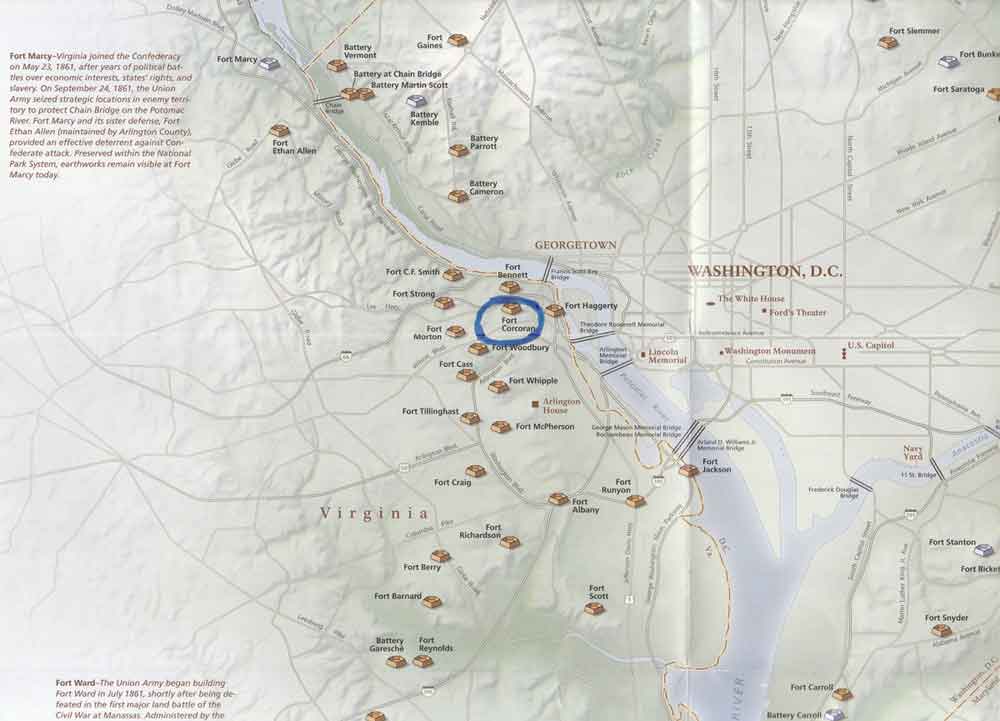 This map shows some of the forts established around Washington, D.C. during the American Civil War. John Fitzpatrick has circled Fort Corcoran. This image is courtesy of the National Park Service.
This map shows some of the forts established around Washington, D.C. during the American Civil War. John Fitzpatrick has circled Fort Corcoran. This image is courtesy of the National Park Service.
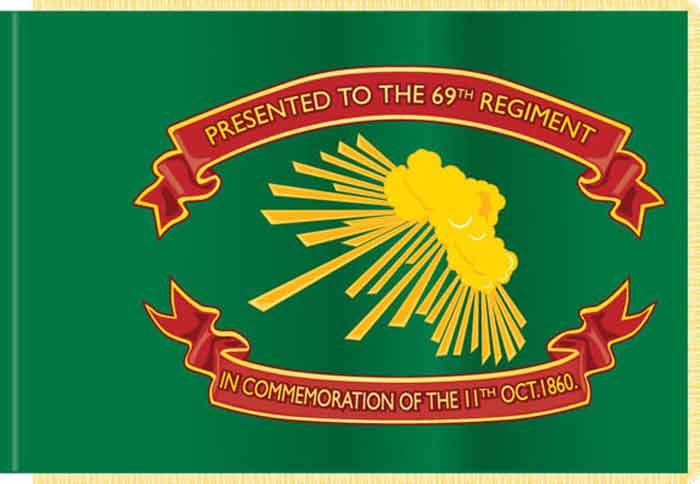 This is the “Prince of Wales” flag which clearly and unambiguously refers to October 11, 1860 which is the date when the 18 year old Prince of Wales, son of Queen Victoria, later King Edward VII, visited New York City. The upper red riband on that flag reads, “PRESENTED TO THE 69TH REGIMENT.” The lower red riband reads, IN COMMEMORATION OF THE 11TH OCT. 1860.” The 69th New York State Militia was ordered to march in a parade in his honor. Colonel Corcoran refused. He was protesting the inadequate and ineffective response of the British government to the potato famine in Ireland [1845-1850] where approximately one million Irish-British subjects starved to death and approximately another two million emigrated in coffin ships to Australia, Canada and the United States. Corcoran was relieved of command and court-martial proceedings were instituted. The charges were dropped when the 69th New York State Militia responded to President Lincoln’s call to defend Washington City. The painting of the Prince of Wales Flag is courtesy of artist Erik Chipchase at mercenarygraphics.com.His e-mail address is echipchase@mercenary graphics.com.
This is the “Prince of Wales” flag which clearly and unambiguously refers to October 11, 1860 which is the date when the 18 year old Prince of Wales, son of Queen Victoria, later King Edward VII, visited New York City. The upper red riband on that flag reads, “PRESENTED TO THE 69TH REGIMENT.” The lower red riband reads, IN COMMEMORATION OF THE 11TH OCT. 1860.” The 69th New York State Militia was ordered to march in a parade in his honor. Colonel Corcoran refused. He was protesting the inadequate and ineffective response of the British government to the potato famine in Ireland [1845-1850] where approximately one million Irish-British subjects starved to death and approximately another two million emigrated in coffin ships to Australia, Canada and the United States. Corcoran was relieved of command and court-martial proceedings were instituted. The charges were dropped when the 69th New York State Militia responded to President Lincoln’s call to defend Washington City. The painting of the Prince of Wales Flag is courtesy of artist Erik Chipchase at mercenarygraphics.com.His e-mail address is echipchase@mercenary graphics.com.
Father William Corby, CSC is seated on the right of this image taken at Harrison’s Landing during the 1862 Peninsula Campaign. The man to his right and the man standing on the right are also priest-chaplains from the University of Notre Dame. Father Corby, technically the Chaplain of the 88th New York, was the actual Chaplain for the entire Irish Brigade at Gettysburg in that one chaplain was sick and the other serving at a military hospital in Washington, D.C. This image is courtesy of the Library of Congress.
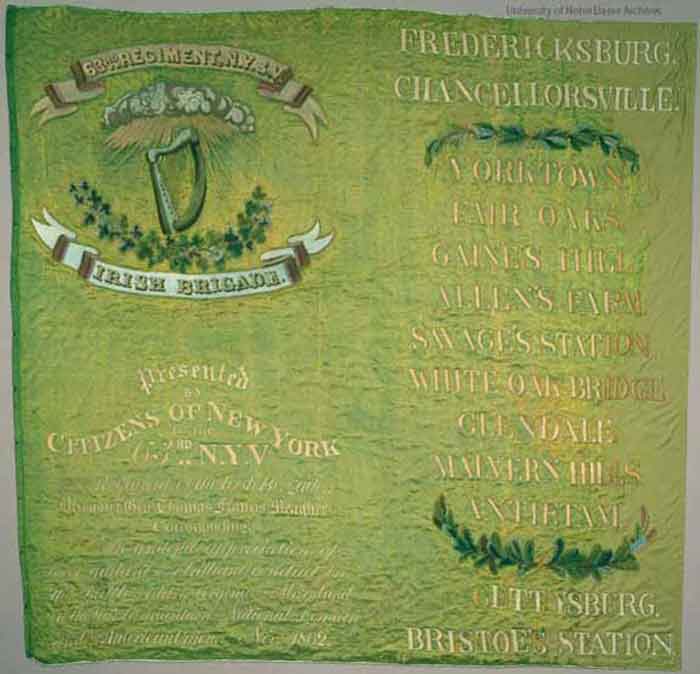 This is the second “Green Flag” of the 63rd New York Infantry Regiment. The “First” Green Flags of the 69th, 88th and 63rd New York Volunteer Infantry, the core Regiments of the Irish Brigade were so badly damaged, particularly during the fight in front of the sunken “Bloody Lane” at the Battle of Antietam, September 17, 1862, that replacement flags were ordered. Please note the date of November 1862 in the lower left of “BRISTOE STATION”. The flags did not arrive in time to be officially adopted prior to the Battle of Fredericksburg, December 13, 1862, but they were issued to each regiment well before the battle of Gettysburg. Father Corby returned to Notre Dame and served two terms as President of the University. He specifically requested that, upon his death, he would be buried with a military funeral. It was granted and many Irish Brigade veterans and their families participated. This restored Second Green Flag of the 63rd New York Volunteer Infantry was donated to the University by those Veterans in his honor and memory. This image is courtesy of the University of Notre Dame Archives.
This is the second “Green Flag” of the 63rd New York Infantry Regiment. The “First” Green Flags of the 69th, 88th and 63rd New York Volunteer Infantry, the core Regiments of the Irish Brigade were so badly damaged, particularly during the fight in front of the sunken “Bloody Lane” at the Battle of Antietam, September 17, 1862, that replacement flags were ordered. Please note the date of November 1862 in the lower left of “BRISTOE STATION”. The flags did not arrive in time to be officially adopted prior to the Battle of Fredericksburg, December 13, 1862, but they were issued to each regiment well before the battle of Gettysburg. Father Corby returned to Notre Dame and served two terms as President of the University. He specifically requested that, upon his death, he would be buried with a military funeral. It was granted and many Irish Brigade veterans and their families participated. This restored Second Green Flag of the 63rd New York Volunteer Infantry was donated to the University by those Veterans in his honor and memory. This image is courtesy of the University of Notre Dame Archives.
(A full size replica of this flag hangs in Dail Eireann. It was presented to the Irish people by US President John F. Kennedy during his visit in 1963)

